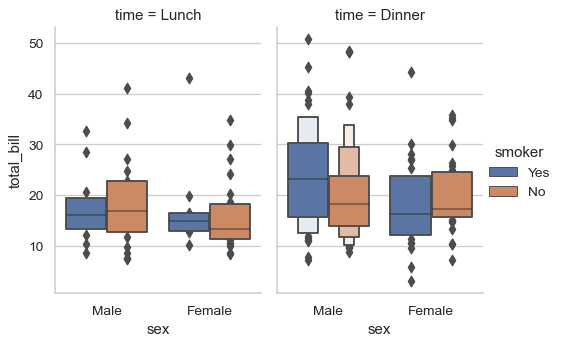seaborn.boxenplot(*, x=None, y=None, hue=None, data=None, order=None, hue_order=None, orient=None, color=None, palette=None, saturation=0.75, width=0.8, dodge=True, k_depth='tukey', linewidth=None, scale='exponential', outlier_prop=0.007, trust_alpha=0.05, showfliers=True, ax=None, **kwargs)¶Draw an enhanced box plot for larger datasets.
This style of plot was originally named a “letter value” plot because it shows a large number of quantiles that are defined as “letter values”. It is similar to a box plot in plotting a nonparametric representation of a distribution in which all features correspond to actual observations. By plotting more quantiles, it provides more information about the shape of the distribution, particularly in the tails. For a more extensive explanation, you can read the paper that introduced the plot:
https://vita.had.co.nz/papers/letter-value-plot.html
Input data can be passed in a variety of formats, including:
Vectors of data represented as lists, numpy arrays, or pandas Series
objects passed directly to the x, y, and/or hue parameters.
A “long-form” DataFrame, in which case the x, y, and hue
variables will determine how the data are plotted.
A “wide-form” DataFrame, such that each numeric column will be plotted.
An array or list of vectors.
In most cases, it is possible to use numpy or Python objects, but pandas objects are preferable because the associated names will be used to annotate the axes. Additionally, you can use Categorical types for the grouping variables to control the order of plot elements.
This function always treats one of the variables as categorical and draws data at ordinal positions (0, 1, … n) on the relevant axis, even when the data has a numeric or date type.
See the tutorial for more information.
data or vector data, optionalInputs for plotting long-form data. See examples for interpretation.
Dataset for plotting. If x and y are absent, this is
interpreted as wide-form. Otherwise it is expected to be long-form.
Order to plot the categorical levels in, otherwise the levels are inferred from the data objects.
Orientation of the plot (vertical or horizontal). This is usually
inferred based on the type of the input variables, but it can be used
to resolve ambiguity when both x and y are numeric or when
plotting wide-form data.
Color for all of the elements, or seed for a gradient palette.
Colors to use for the different levels of the hue variable. Should
be something that can be interpreted by color_palette(), or a
dictionary mapping hue levels to matplotlib colors.
Proportion of the original saturation to draw colors at. Large patches
often look better with slightly desaturated colors, but set this to
1 if you want the plot colors to perfectly match the input color
spec.
Width of a full element when not using hue nesting, or width of all the elements for one level of the major grouping variable.
When hue nesting is used, whether elements should be shifted along the categorical axis.
The number of boxes, and by extension number of percentiles, to draw.
All methods are detailed in Wickham’s paper. Each makes different
assumptions about the number of outliers and leverages different
statistical properties. If “proportion”, draw no more than
outlier_prop extreme observations. If “full”, draw log(n)+1 boxes.
Width of the gray lines that frame the plot elements.
Method to use for the width of the letter value boxes. All give similar results visually. “linear” reduces the width by a constant linear factor, “exponential” uses the proportion of data not covered, “area” is proportional to the percentage of data covered.
Proportion of data believed to be outliers. Must be in the range
(0, 1]. Used to determine the number of boxes to plot when
k_depth="proportion".
Confidence level for a box to be plotted. Used to determine the
number of boxes to plot when k_depth="trustworthy". Must be in the
range (0, 1).
If False, suppress the plotting of outliers.
Axes object to draw the plot onto, otherwise uses the current Axes.
Other keyword arguments are passed through to
matplotlib.axes.Axes.plot() and
matplotlib.axes.Axes.scatter().
Returns the Axes object with the plot drawn onto it.
See also
violinplotA combination of boxplot and kernel density estimation.
boxplotA traditional box-and-whisker plot with a similar API.
catplotCombine a categorical plot with a FacetGrid.
Examples
Draw a single horizontal boxen plot:
>>> import seaborn as sns
>>> sns.set_theme(style="whitegrid")
>>> tips = sns.load_dataset("tips")
>>> ax = sns.boxenplot(x=tips["total_bill"])
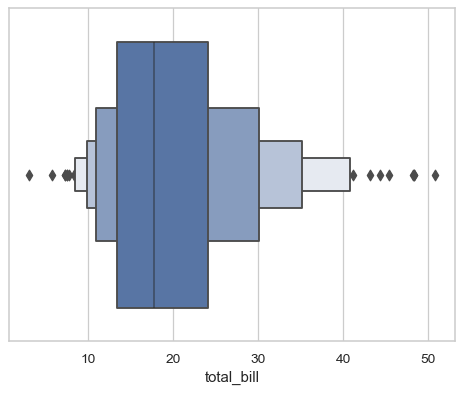
Draw a vertical boxen plot grouped by a categorical variable:
>>> ax = sns.boxenplot(x="day", y="total_bill", data=tips)
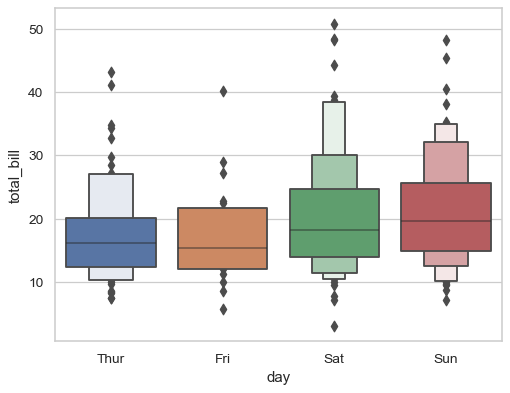
Draw a letter value plot with nested grouping by two categorical variables:
>>> ax = sns.boxenplot(x="day", y="total_bill", hue="smoker",
... data=tips, palette="Set3")
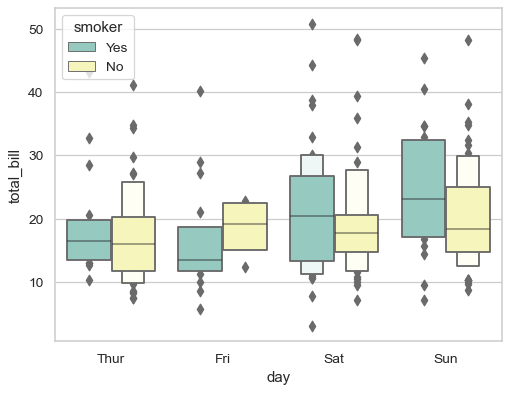
Draw a boxen plot with nested grouping when some bins are empty:
>>> ax = sns.boxenplot(x="day", y="total_bill", hue="time",
... data=tips, linewidth=2.5)
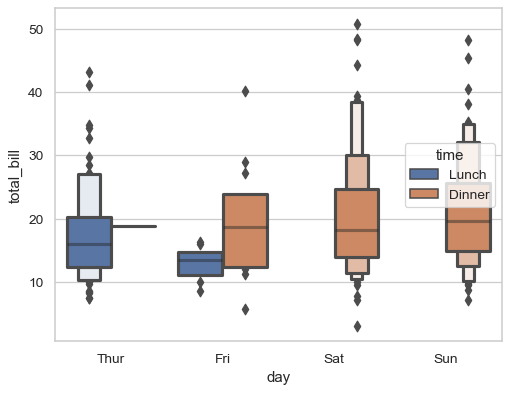
Control box order by passing an explicit order:
>>> ax = sns.boxenplot(x="time", y="tip", data=tips,
... order=["Dinner", "Lunch"])
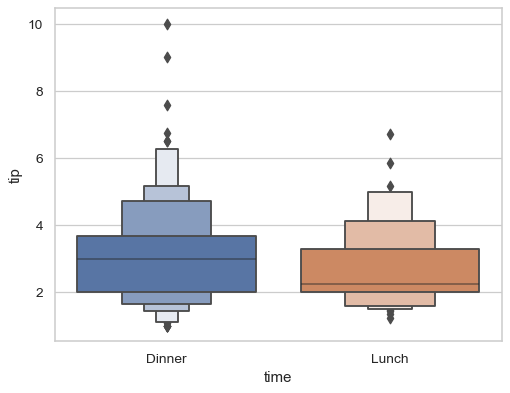
Draw a boxen plot for each numeric variable in a DataFrame:
>>> iris = sns.load_dataset("iris")
>>> ax = sns.boxenplot(data=iris, orient="h", palette="Set2")

Use stripplot() to show the datapoints on top of the boxes:
>>> ax = sns.boxenplot(x="day", y="total_bill", data=tips,
... showfliers=False)
>>> ax = sns.stripplot(x="day", y="total_bill", data=tips,
... size=4, color=".26")
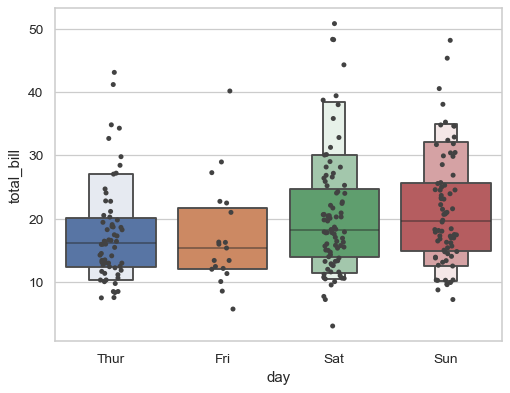
Use catplot() to combine boxenplot() and a FacetGrid.
This allows grouping within additional categorical variables. Using
catplot() is safer than using FacetGrid directly, as it
ensures synchronization of variable order across facets:
>>> g = sns.catplot(x="sex", y="total_bill",
... hue="smoker", col="time",
... data=tips, kind="boxen",
... height=4, aspect=.7);
